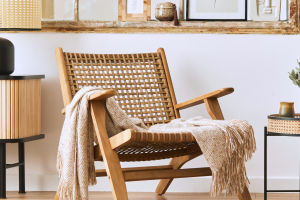
When we think of minimalism, a cold and stark aesthetic might come to mind.
But what if we told you that a clutter-free home could also feel warm, inviting, and full of personality?
The secret lies in combining simple designs with natural materials and deep tones. Let's explore ten ways to achieve a home that is both minimal and cozy!
1. Use Dark Tones as a Backdrop
Dark tones can set the stage for a warm minimalist space. Instead of creating a cold and sterile look, deep colors like charcoal, navy, or forest green add richness and sophistication. Pair them with natural wood and soft lighting to create an atmosphere that is both elegant and welcoming.
2. Choose Natural Materials
A minimalist home doesn't have to feel lifeless. Incorporating materials such as wood, stone, and woven textiles can make all the difference. Imagine a living room filled with wooden furniture, jute rugs, and linen curtains—each element adds warmth and texture without overwhelming the space.
3. Prioritize Comfort in Design
Minimalism doesn't mean sacrificing comfort. Soft cushions, linen tablecloths, and natural-fiber accessories can enhance the coziness of a room. Choose furniture with smooth, organic shapes and fabrics that invite touch, ensuring the space feels as good as it looks.
4. Keep Sight Lines Clear
A clutter-free space doesn't have to feel empty. By focusing on clean sight lines, we allow each design element to stand out while maintaining a sense of openness. Built-in furniture and well-placed decor can contribute to a visually calming space without feeling sparse.
5. Invest in Smart Storage Solutions
An elegant, minimalist home requires thoughtful storage solutions. Hidden compartments, floating shelves, and multi-functional furniture help maintain order while keeping necessary items accessible. By organizing effectively, we can enjoy the beauty of simplicity without sacrificing functionality.
6. Choose Fewer, Better Pieces
Quality over quantity is key to warm minimalism. Instead of filling a room with decorative clutter, focus on a few well-crafted items that truly stand out. A striking pendant light, a beautifully designed coffee table, or a carefully chosen piece of artwork can serve as focal points, making the space feel intentional and refined.
7. Layer in Tactile Textures
A room that looks good should also feel inviting. Introduce soft, touchable materials such as wool throws, velvet cushions, or woven rugs to add depth. These subtle layers bring a cozy and sophisticated touch without disrupting the minimalist aesthetic.
8. Incorporate Wood Paneling
Wood paneling can instantly make a space feel more intimate. Whether it's a full wall or a simple wooden feature, the warm tones of natural wood bring a grounded and timeless appeal. If full-scale paneling isn't an option, wooden furniture and shelves can achieve a similar effect.
9. Blend Industrial and Natural Elements
Minimalism doesn't have to be rigid. Mixing industrial elements, such as metal light fixtures or exposed beams, with natural materials like wood and linen can create a space that is both structured and inviting. The contrast between these textures adds visual interest while maintaining a cohesive design.
10. Allow the Space to Breathe
The final touch to warm minimalism is knowing when to stop. By keeping clutter hidden and allowing decorative pieces to shine, we create a home that feels both serene and inviting. A minimalist bathroom, for example, can be transformed with elegant mirrors, soft towels, and thoughtful lighting—all while keeping everyday essentials out of sight.
Embracing warm minimalism in your home is about creating a serene, clutter-free space where every item serves a purpose!


